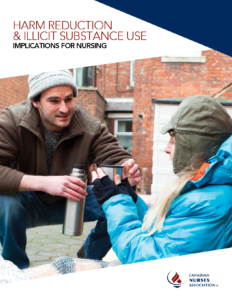
Harm Reduction and Illicit Substance Use: Implications for Nursing

Executive Summary
Nurses frequently care for people experiencing the impact of substance use, regardless of the settings in which they work. Yet, providing nursing care in the context of illicit substance use can raise questions for nurses and have an impact on the provision of care.
The focus of this paper is specifically on the health and social harms associated with illicit substance use. Harm reduction is a public health response aimed at reducing the negative consequences of actions that increase the risk of adverse health outcomes, including substance use.
The paper presents current perspectives and evidence on harm reduction policy and practice and identifies the implications for nursing policy, practice, research and edu-cation. It is anticipated that this information will inform discussions about appropriate policies, practices and standards to improve the delivery of health care. Nurses can and should be involved in the development of organizational and governmental policies related to harm reduction strategies. Such policies must be grounded in the best evidence available and embedded within a human rights, health equity and social justice framework.
There are two dominant policy approaches to reducing the harms of illicit substance use: (1) an approach that uses prohibition and law enforcement to criminalize substance possession and use, and (2) a public health approach that seeks safer use of illicit substances to reduce harms to health and well-being. A review of international, national, provincial and municipal policies highlights the tensions between these two approaches. In Canada, federal, provincial and territorial policies are shifting toward harm reduction, in light of the 9-0 Supreme Court decision in 2011 to exempt super-vised injection sites from prosecution along with the Canadian government’s intention to legalize the distribution and regulation of cannabis (marijuana). Globally, however, tensions remain. Discussions from the 2016 UN meetings appear to endorse status quo law enforcement policies. Unfortunately, despite the strong evidence for the public health perspective, a policy schism continues that does little to support nurses in their provision of evidence-informed care.
There is substantial empirical evidence to support the benefits of harm reduction strategies in terms of public health and safety. Needle distribution and recovery programs have been shown to be safe, effective and economical ways of decreasing the risk of HIV transmission while increasing access to health and social services for people who use injected substances. Outreach strategies are a low-cost, effective means of reaching people who use substances and are particularly effective when they are peer-based. Supervised consumption services also lower the rate of overdose deaths and the risk of HIV transmissions while increasing access to substance treatment and reducing public disorder. As well, opioid agonist treatments like methadone, buprenorphine/ naloxone (Suboxone) or diacetylmorphine (prescription heroin) are safe and cost-effective approaches. Studies of diacetylmorphine have shown that the practice improves health outcomes and reduces illicit substance use and crime without any negative impacts on the community. The evidence further suggests that supervised consumption facilities such as Insite in B.C. should continue to expand into other Canadian municipalities where substance use, overdose deaths and the transmission of communicable diseases are prevalent.
Still, a review of the literature revealed a research gap related to models of delivering harm reduction services (such as needle distribution and recovery sites and supervised consumption facilities) and the nurse’s role in them — which can offer a response to ongoing objections to harm reduction. Not only are these objections without grounding in evidence, they are often incompatible with community sentiments: public opinion surveys frequently show support for such programs.
Nursing professional and ethical standards are consistent with the values of harm reduction and require nurses to use the best evidence available in their practice. In the sections that follow we discuss legal and ethical perspectives on the distribution of harm reduction supplies, supervised consumption services and the provision of nursing care to people who use illicit substances.

